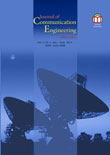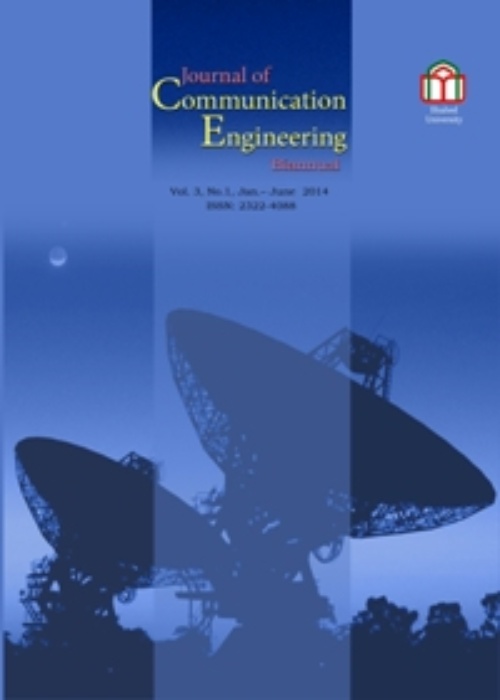فهرست مطالب

Journal of Communication Engineering
Volume:5 Issue: 2, Autumn 2016
- تاریخ انتشار: 1395/09/30
- تعداد عناوین: 6
-
-
Pages 21-25This paper concerns the transmission of two independent Gaussian sources over a two-user decentralized interference channel, assuming that the transmitters are unaware of the instantaneous CSIs. The availability of the channel state information at receivers (CSIR) is considered in two scenarios of perfect and imperfect CSIR. In the imperfect CSIR case, we consider a more practical assumption of having an MMSE estimation of the channel gain at the receivers. In this case, minimizing the expected achievable distortion associated with each link is considered. Due to the absence of CSI at the transmitters, the Gaussian sources are encoded in a successively refinable manner and the resulting codewords are transmitted over the channel using a multi-layer coding technique. Accordingly, the optimal power assignment between code layers leading to the least expected achievable distortion, under a mean-square error criterion is derived for both, the perfect and imperfect CSIR scenarios. Finally, some numerical examples are provided and it is demonstrated that the proposed method results in better performance as compared with the conventional single-layer approach, termed as outage approach.Keywords: Distortion, Multi-layer Coding, Successive refinement, Interference Channel
-
Pages 25-51This paper presents a novel microstrip low-pass filter with good performance. A complete detailed theoretical analysis for the proposed filter is given using equivalent circuit models. The proposed filter applying multiple cascaded modified radial stubs resonators provides a sharp cut off frequency response that has a 185 dB/GHz roll off rate. Also, U-shaped attenuators provide a wide stop-band about 14fc with more than -20 dB rejection. The filter has an insertion loss less than 0.027 dB from dc to 1.31 GHz. The proposed filter has a high figure of merit, equal to 32317. The experimental results are in fair agreement with the simulated results.Keywords: Low-pass filter, Microstrip, Radial stub, Sharp roll, Wide stop-band
-
Pages 64-75Design, simulation and optimal selection of cosine-linear frequency modulation waveform (CNLFM) based on correlated ambiguity function (AF) method for the purpose of Synthetic Aperture Radar (SAR) is done in this article. The selected optimum CNLFM waveform in contribution with other waveforms are applied directly into a SAR image formation algorithm (IFA) and their quality effects performance in comparison to each other is analyzed. The quality performance analysis includes both the qualitative AF diagrams and the objective image quality metrics assessments. Then, by changing the SAR system parameters based on the proposed CNLFM waveform, other quality metrics are also derived. The simulation results verifies the robustness of the proposed CNLFM waveform implementation as a suitable NLFM alternative for LFM waveform.Keywords: Synthetic Aperture Radar, Non-Linear Frequency Modulation (NLFM), Ambiguity Function (AF), image formation algorithm (IFA), Waveform
-
Page 71Body centric wireless communication (BCWC) has been the topic of much research in recent years. In this manuscript, a novel low-cost microstrip patch antenna is designed for on-/off-body communications with a dual-band operation. The proposed structure exhibits a monopole-like radiation pattern at 2.45GHz and a broadside radiation at 4.8GHz, simultaneously. Lateral dimensions of 42 mm × 46 mm and a low profile foam substrate with the thickness of 2.5 mm are considered for the dual-mode presented antenna. The proposed low-cost structure is fabricated and the stability of its performances under the human body effects is investigated through both simulation and measurement results. The experimental results are in good agreement with the simulated ones.Keywords: Body centric wireless communication (BCWC), on- off-body communications, dual band patch antenna
-
Page 106A power divider (PD)/ power combiner (PC) with high quality factor and enhanced output ports isolation using substrate integrated waveguide (SIW) technology is proposed. An SIW cavity is designed to provide a high quality factor filtering response and an SMD resistor is attached between two output ports to realize the high isolation. The value of the applied resistor is calculated by using the even and odd mode analysis. The measured results obtained from testable model are in a good agreement with the simulated results. These results show that the return loss is 23 dB, the minimum insertion loss is 4.55 dB including intrinsic 3 dB insertion loss of PD, and the isolation between output ports is 20 dB, which seems the proposed design could be an important component in microwave circuits.Keywords: Cavity resonator, power combiner, power divider, Q-factor, substrate integrated waveguide (SIW)
-
Page 136Clustering is an effective approach for managing nodes in Wireless Sensor Network (WSN). A new method of clustering mechanism with using Binary Gravitational Search Algorithm (BGSA) in WSN, is proposed in this paper to improve the energy consumption of the sensor nodes.Reducing the energy consumption of sensors in WSNsis the objective of this paper that is through selecting thesub optimum sensors as Cluster Heads (CHs) to eliminate the number of transmissions and subsequently to attain more network lifetime. Clustering mechanism is consist of two phases: CH selection and cluster formation. One of the major problem affecting energy consumption in WSN is cluster head selection. Proposed method is used for selecting suboptimum cluster head nodes. However, selecting CHs is not easy subject, in this paper this issue will be discussed based on the residual energy or distance from Base Station (BS) or both of them with considering BScoordinate by BGSA algorithm. Simulation results show that if the BS is not very far from the network area, considering distance and residual energy for selecting CHs by proposed method can be efficient for reducing energy consumption and prolonging lifetime.Keywords: Wireless Sensor Networks, Binary Gravitational Search Algorithm, Cluster Heads, Energy consumption, Distance from BS


